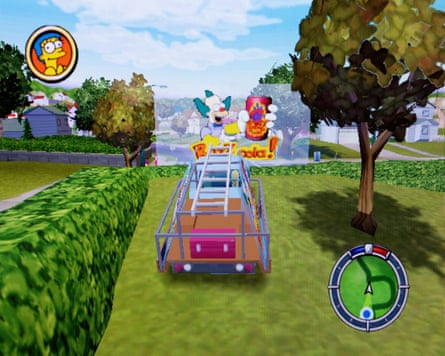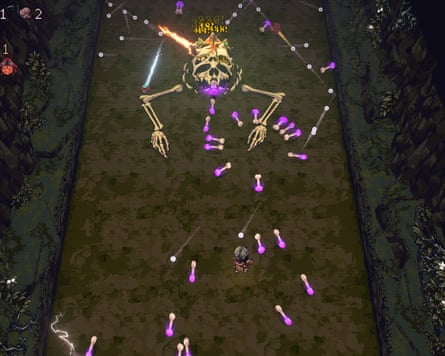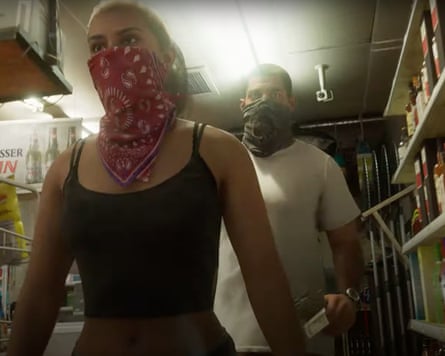And so Fortnite has done it again. Over the past five years, developer Epic Games maintained the relevance and awareness of its ageing online shooter by churning out pop culture collaborations, from Marvel to John Wick to Sabrina Carpenter. For limited periods, players get to take part in the game as their favourite movie characters and music artists, an arrangement that provides refreshed audience numbers for the game – and a tidy revenue stream for the brands.
Now it’s the turn of The Simpsons. This month, the Fortnite island has become a miniature Springfield, complete with popular characters and well-known locations. If you want to play as Homer and shoot up Moe’s Tavern, you can. If you want to take Bart to Kwik-E-Mart for a squishee, go ahead. Everywhere you look there’s a fun little Simpsons Easter egg, from the fact that the Battlebus (which delivers players on to the island) is now driven by Otis to the presence of Duffman, Seymour Skinner’s steamed hams and drooling aliens.
But the Fortnite tie-in is only the latest example of a longstanding and symbiotic relationship between The Simpsons and video games. In 1991, less than two years after the show’s debut, Acclaim released Bart vs The Space Mutants, a side-scrolling platformer in which Bart must defeat an extraterrestrial invasion by doing frustrating pixel-perfect jumps and fighting bosses including Nelson and Sideshow Bob, while “enjoying” a scratchy sound sample of “eat my shorts” over and over again.
Despite mediocre reviews, the game sold 1m copies, and inspired a rash of Bart-focused games such as Bart vs The World and Bart’s House of Weirdness. This interplay made perfect sense; Bart is, of course, a huge video game fan, and in the early days of the show, when he was the focal point of the writing, he represented the target demographic of the contemporary games industry: a mischievous 10-year-old boy with an interest in comical violence.
The relationship would come to the fore in the classic 1995 Christmas episode Marge Be Not Proud in which Bart watches a TV ad for a hyper-violent hack-’em-up named Bonestorm. (The commercial has a muscular Santa bursting into a family living room holding a rocket launcher and yelling: “Tell your folks, buy me Bonestorm or go to hell!”) It’s a clear parody of the frenzied, super-targeted marketing behind 1992’s Mortal Kombat, a game Bart would have relished thanks to its array of decapitations and eviscerations. At the end of the episode, Bart gets a video game for Christmas, but it’s the joyously sedate Lee Carvallo’s Putting Challenge. It’s funny, but it is also symbolic of the console war at the time: the rebellious Sega Mega Drive v the family-friendly Nintendo Entertainment System.

The best early Simpsons game would arrive a few months after Bart vs Space Mutants. Konami’s 1992 arcade hit, The Simpsons, is an excellent four-player brawler in which the family is pitted against Mr Burns – who has, in a daft plot that is just an excuse to visit a lot of Springfield locations and attack enemies with skateboards and vacuum cleaners – kidnapped Maggie. My favourite example from the 1990s, though, was the 1996 PC release The Simpsons Cartoon Studio, which gave players a range of locations, characters and soundbites from the show in order to create their own mini Simpsons cartoons – a little foretaste of the TikTok memes Fortnite Simpsons fans are bound to make and share.
Meanwhile, the show itself has kept finding new ways to gently satirise video games. Springfield’s regularly featured arcade Noiseland is crammed with amusing coin-operated games from Jane Fonda’s Legwarmers of Death to the wonderful My Dinner With André from season five’s Boy-Scoutz ’n the Hood (press up on the joystick to offer “Trenchant Insight”). But games are also used as a useful pop cultural tool for poking fun at the characters themselves. The favourite game of the godly Flanders kids is Billy Graham’s Bible Blaster, an evangelical preach-’em-up that has Rod Flanders shouting, “Keep firing; convert the heathens!”

However, the Simpsons video game that probably best foreshadows the Fortnite tie-in is 2003’s much-loved Simpsons Hit & Run, a glorious Homer-fronted pastiche of Grand Theft Auto. Here you can drive around town visiting Android’s Dungeon, Krusty Burger and the Legitimate Businessman’s Social Club, while carrying out missions to prevent another alien plot. This was, to be honest, the last great Simpsons title, and it’s interesting how a lot of the games press coverage of the Fortnite tie-in is essentially: “I’d rather have Hit & Run 2, but I guess this will do.”
What the collaboration really shows is how The Simpsons has continued to survive as a cultural icon, despite its decline as a must-watch TV phenomenon. The heady combination of slapstick, parody and social commentary aligns with the scrambled self-aware narratives of video games, where crazed violence often intercuts with gooey sentimentality and knockabout laughs. Both The Simpsons and video games came of age in the early 1990s, a hyperactive postmodern theme park of an era, and they have both continued to explore and exploit the worst excesses of our consumer society. Fortnite might not be the place we wanted to find a proper modern Simpsons game, but it makes sense for it to be here – a palace of memes, soundbites and cartoonish antics that will no doubt continue to generate fun and money for many years to come.
What to play

Despite how much I am enjoying it, I believe that Ball x Pit may be a work of great evil. A concerningly potent combination of Space Invaders, Vampire Survivors and old ball-bouncing action games such as Breakout, it is a dungeon-delving arcade game in which you fire balls at lines of descending skeleton hordes as you descend down a bottomless pit. The balls bounce off enemies, or burn them, poison them, pass through them; every wave of defeated creatures unlocks a new suite of perks and bonuses and upgrades for you to combine. Above ground, you build a base for your characters and ping them about to harvest wood and stone to build yet more. The screen is always visually cacophonous, crowded with mesmerising waves of creatures and spells and bouncing balls. Most of the time I feel as if it’s playing itself. But still: it’s just so absorbing. Keza MacDonald
Available on: Nintendo Switch, PS5, Xbox, PC, Mac
Estimated playtime: Possibly forever, in 15-20 minute bursts
What to read

-
The Independent Workers Union of Great Britain, which represents a huge variety of gig economy workers including those on contracts at video game studios, has accused Grand Theft Auto VI producer Rockstar Games of “the most blatant and ruthless act of union-busting in the history of the games industry”. Rockstar has denied the accusations stating that at least 30 IWGB union members at Rockstar Lincoln were fired for “gross misconduct”.
-
Some good old-fashioned console sales news: Nintendo’s Switch 2 has sold almost 11m units since its launch in June, putting it comfortably ahead of the PlayStation 5 as the biggest console launch in history. The original Switch, meanwhile, is on track to become Nintendo’s all-time bestselling console with more than 154m sales, and in a few years it could beat the PlayStation 2 for the overall record (160m).
-
Some of Halo’s co-creators have responded to the Trump administration’s use of video game memes to recruit for ICE. Via Game File, Master Chief’s designer Marcus Lehto said: “It really makes me sick seeing Halo co-opted like this”, while designer Jaime Griesemer called it “despicable”. Meanwhile Martin O’Donnell, the composer of Halo’s legendary soundtrack, is running for Congress in Nevada as a Republican and posted: “I will work with the Trump administration to destroy the Flood once and for all!”
after newsletter promotion
What to click
-
Football Manager 26 – a modern sim for the modern game | ★★★★☆
-
The Outer Worlds 2 – improved space-faring sequel is an enjoyable time sink | ★★★☆☆
-
How Mortal Kombat (and moral panic) changed the gaming world
-
Inside the secret psychology of horror games – and why we can’t help pushing play
-
A PowerWash Simulator sequel is exactly what we need right now | Ellie Gibson
Question Block

Reader Kirk asks this week’s question:
“I’m impressed by the beauty of many games, but I’m disappointed that so many are so violent. Is it, perhaps, that coming up with interesting games that don’t involve fighting is too difficult? Not all games are violent, but all the big-budget games seem to be.”
This is a much-discussed question among game designers and thinkers. Since Space Invaders, video games have presented players with an enemy to defeat: without competition and combat and adrenaline, how do you make it fun? Some see conflict as a driving force behind most stories, an almost inevitable part of game design. Others view video game violence as a failure of imagination.
On Gamesindustry.biz in 2017, the game designer Brie Code posited that most games were geared towards inducing a fight-or-flight stress response in the player, and wrote about how games might move towards a different modality: tend-and-befriend. “What is game design missing? I ask this question in terms of game mechanics and game systems. I ask in terms of adrenaline, dopamine, oxytocin, opioids, and other reward systems. I ask in terms of gameplay, that helps a wider range of people understand themselves and their responses to stress and to the world.”
I am also reminded of a Game Developer essay by Brian Fairbanks. “Life is complicated, messy, stressful and painful. Our problems take so many forms, and our chosen entertainment takes those problems, distills them into a single entity and puts a Foe badge on them,” he wrote. “The issue here is, in nonviolent games, we don’t have access to that power in the same way. Our games are structured so that the challenge and progression does not revolve around literally destroying your problems with weapons. We have to find other ways to get there.”
By the way, there are a great many non-violent games around. Some of them, such as Animal Crossing, certainly count as blockbusters. There’s no comprehensive database off them, but ThinkyGames is the closest (you can filter out action, combat and timing), and there’s also an active non-violent entertainment curation page on Steam. For family friendly, violence-free games, Common Sense Media is a good resource. KM
If you’ve got a question for Question Block – or anything else to say about the newsletter – email us on [email protected].

 3 weeks ago
22
3 weeks ago
22

















































